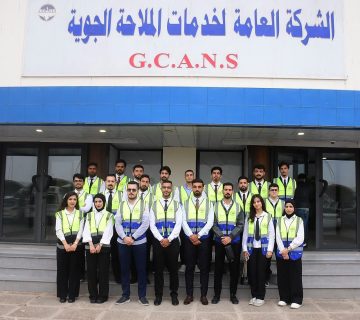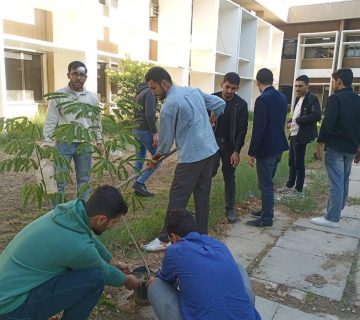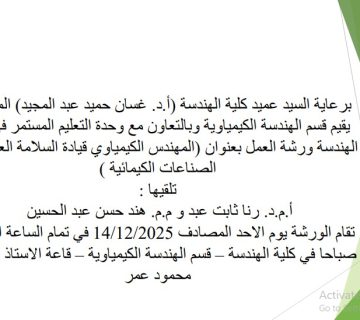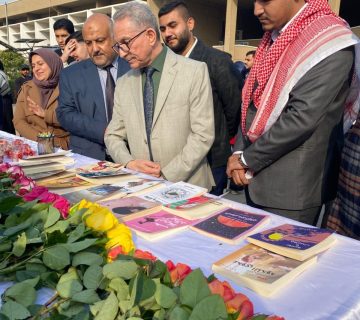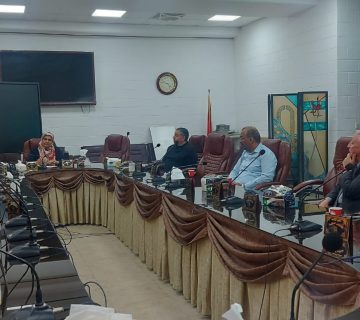تم مناقشة رسالة الماجستير للطالب / فؤاد جواد زاجي الفاضلي في قسم الهندسة الميكانيكية عن البحث الموسوم (دراسة عددية وعملية للحمل الحرفي حيز مملوء جزئيا بوسط مسامي) في يوم الخميس الموافق 4-11- 2020 وبأشراف أ.م.د لمى فاضل علي
وقد تشكلت لجنة المناقشة من السادة
- اللقب العلمي جامعة البصرة / كلية الهندسة أ.د.منيرعبد الجليل اسماعيل رئيسا
- اللقب العلمي جامعة بغداد / كلية الهندسة أ.م.عصام محمد علي عضوا
- اللقب العلمي جامعة بغداد / كلية الهندسة م.د. رائد كاطع صيهود عضوا
- اللقب العلمي جامعة بغداد/ كلية الهندسة أ.م.د لمى فاضل علي مشرفا
تناول البحث
دراسة تاثير الحمل الحر في وسط مملوء بصورة جزئية مع مجموعة من المتغيرات التي تحاكي بعض التطبيقات الهندسية والعملية .
ملخص عن الرسالة / الاطروحة
Steady natural convection heat transfer in an enclosure is availed by an effect of below heating through a constant heat flux has been investigated numerically and experimentally. The three-dimensional enclosure is partially filled by a lower horizontal layer of saturated porous media with same fluid(air) and free fluid occupies the rest of cavity. The enclosure is symmetrical maintained at constant temperature at two opposite vertical side walls, heated the bottom wall by three length values of heater, and insulated the other walls.
The results are displayed in stream function for fluid flow, isotherm contour, local Nusselt number, and average (Nu) for heat transfer. The relevant studied parameters are Darcy number (Da1=4.025×10-8 and Da2=8.852×10-4), Rayleigh number range (60.354-241.41), (1.304×106–5.2166×106) for small porosity(ɛ=0.418) and coarse(ɛ=0.568) respectively, different horizontal porous layer thickness (Hp = 5,10,15 and 20) cm, four values of heat flux(q=150, 300, 450,600)Watt/m2, and three sizes of heater (δ=20,14 and 7)cm.
Due to lack attention in experimental studies of the effects of porous layer thickness on laminar heat convection with cavity heated from below by constant heat flux, the present experimental work has been designed and conducted by use glass beads (ɛ=0.418, Da1) saturated air as porous media in cubic enclosure(20cm) with same investigated boundary conditions for numerical study. The results have been displayed in temperature distribution, local Nu, and average Nu. Additionally, Correlation equations have been resolved for Nu with Ra.
The results show that the effect of the Rayleigh number on the temperature distribution with progressively increasing in the average Nusselt number due to increase the convection heat transfer. Moreover, symmetrical distribution of local Nu along the bottom wall. However, minimum local Nu at midpoint of base wall is found since the conduction mode dominates the heat transfer at this region. Also, it is evident that the heat transfer and fluid flow relies upon the thickness of porous layer (Hp) and be maximum at (Hp=0.25L), which clearly observed (for example) with (δ=20cm and Da2) to be approximately (180%) for the average Nu when comparing with (Hp=0.75L). Additionally, the heat transfer is enhanced for large Darcy number (Da2) influenced by improving the convection heat transfer while it was mainly conduction mode for experimental working for all Raleigh number with a little effect of convection when increase (Ra). The increasing in the heat flux(q) raises the Nusselt number for all cases, and the maximum effecting was found in (q=600Watt/m2). The results showed an enhancement in the average Nu with increasing the heater length to be maximum (25% and 44%) at (δ=20cm) for parameter (Da1and Da2) respectively.
The comparison of numerical work is executed with different cases of enclosure filling. Firstly, with fluid only. Secondly, cavity full filled by porous media, and finally enclosure partially filled with porous layer. The validation results were confirmed the applicability of the work. Also, same comparison was performed between numerical and experimental results (temperature profile and Nusselt number) which follow the same behavior with a difference ratio do not exceed (8%) for all parameters.



